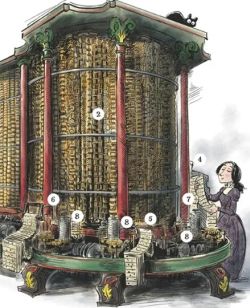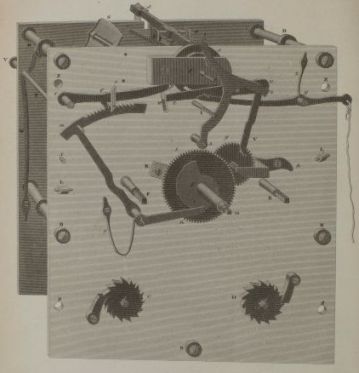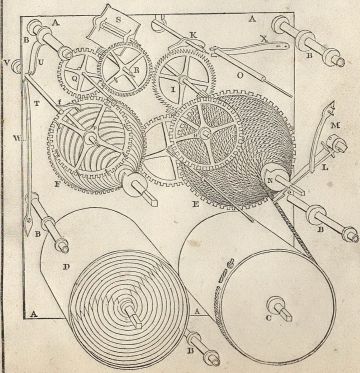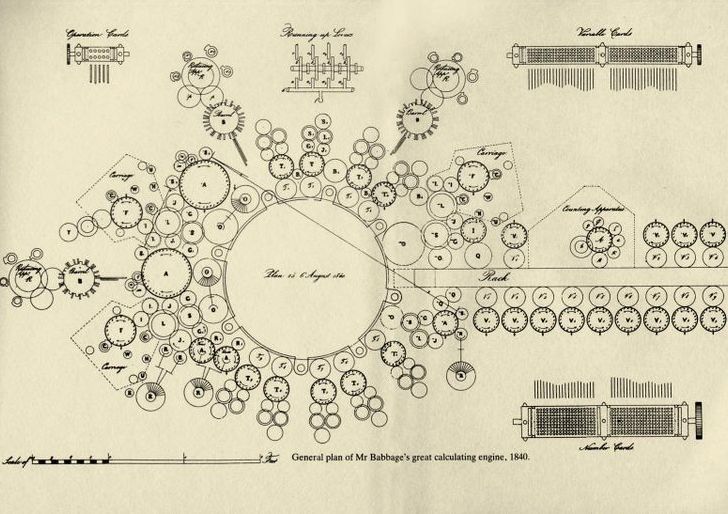A universal notation with symbols employed that are few and simple enough, furnish the most important assistance in the design of the order and succession of the movements in a machine’s engine. This was the most important tool that Mr. Charles Babbage employed in his attempts to construct his celebrated calculating machines. In his own words: “to seek for some method by which I might, at a glance of the eye, select any particular part, and find at any given time its state of motion or rest, its relation to the motions of any other part of the machine, and, if necessary, trace back the sources of its movement through successive stages to the original moving power.” Babbage’s paper: On a method of expressing by signs the action of machinery, was first published in the Philosophical Transactions in the January 1826 issue.
Using the common eight day clock, and the hydraulic ram, Babbage introduced his notation to the scientific community. The eight day clock mechanical drawing used was made up of wheels, pins, revolving barrels, fusee, shafts, etc. His notation denoted engineering measurements of angular velocity, comparative angular velocity, the transmission of circular as well as a longitudinal motion, stiff friction, revolutions, repetitions, and others.
Babbage’s later designs attempted to show the separation of the memory (the ‘Store’) from the central processor (the ‘Mill’), and capture serial operations using a ‘fetch-execute cycle’ (the “Barrel Controllers”), with devices for inputting and outputting data and instructions (“Operation Cards”,”Variable Cards”).
Babbage began to construct a small difference engine circa 1819 and had completed it by 1822 (Difference Engine 0). He announced his invention in June of 1822, in a paper to the Royal Astronomical Society, entitled: Note on the application of machinery to the computation of astronomical and mathematical tables1. A copy of the offprint with the author’s inscription sold at a Christie’s auction below its estimate for $7,200 in 2005. At that time, OCLC cited another copy in existence at the Niedersachsische Staats- und Universitätsbibliothek. Like the central processing unit (CPU) in a modern computer, the mill would rely upon its own internal procedures, to be stored in the form of pegs inserted into rotating drums called “barrels”, to carry out some of the more complex instructions the user’s program specified.
Babbage’s first attempt at making the first Difference Engine fell through, but he shifted his innovation efforts to the design of a more complex machine called the Analytical Engine. The major innovation was that the Analytical Engine was to be programmed using punched cards and use features subsequently used in modern computers, including sequential control, branching and looping. The Engine was not a single physical machine, but rather a succession of designs that Babbage tinkered with until his death in 1871. He never published a detailed description of the Analytical Engine but in 1842, the Italian mathematician Luigi Federico Menabrea published a description of the engine in French, based on a lecture given by Babbage. In 1843, the description was translated into English and extensively annotated by Ada Lovelace, who had become interested in the engine eight years earlier. Her annotated translation has been called by many authorities the most important paper in the history of digital computing before modern times. Babbage considered this paper which is titled: Sketch of the Analytical Engine invented by Charles Babbage … with notes by the translator [Augusta Ada King, Countess of Lovelace], a complete summary of the mathematical aspects of his machine, proving that analytical operations were capable of being executed by machinery. A copy of this offprint from Scientific Memoirs III (1843) London: Richard and John E. Taylor, sold for $78,000, double its estimate, at a Christie’s auction in 2005. OCLC and RLIN cited two copies of the offprint of Lovelace’s translation (both at Harvard University) with three additional copies in private hands.
The logical structure of the Analytical Engine was essentially the same as the one which dominated computer design in the computer age, during when the ENIAC (Electronic Numerical Integrator and Calculator) was completed. Babbage’s work however, has only in recent decades been studied in detail realizing the extent of his accomplishment. What may be the most remarkable aspect of Babbage’s monumental invention in thought and engineering, is the extent to which it was ignored. The limited production of original publications which document his work, coupled with the recent realization of the importance of his work, have become startling intellectual rare finds.
1 Dasgupta, Subrata (2014). It Began with Babbage: The Genesis of Computer Science. Oxford University Press. p. 22. ISBN 978-0-19-930943-6.




{ 1 comment… read it below or add one }
The evolution of computers in the last 150 years is amazing. And its not done yet with AI and quantum computers evolving now.